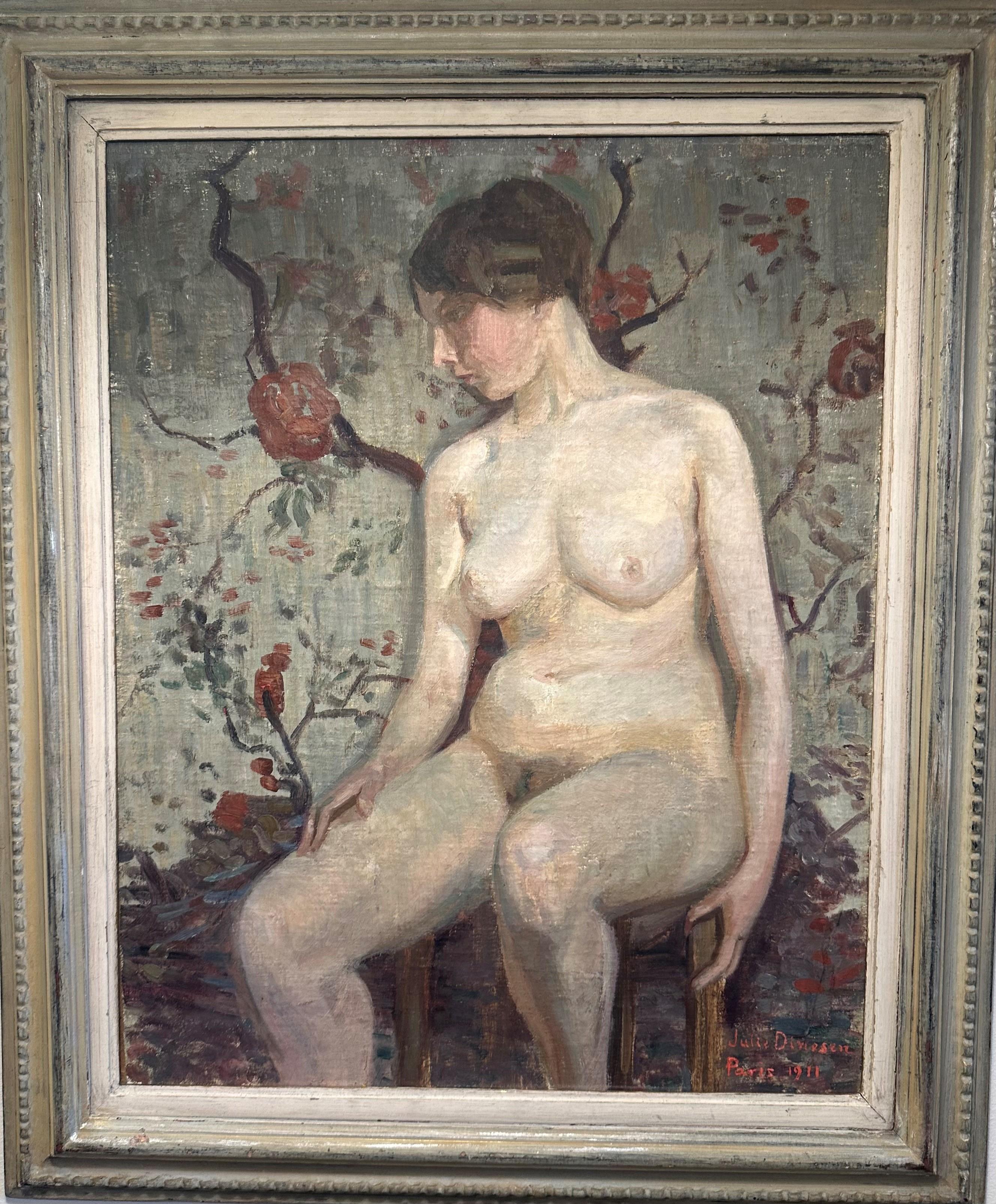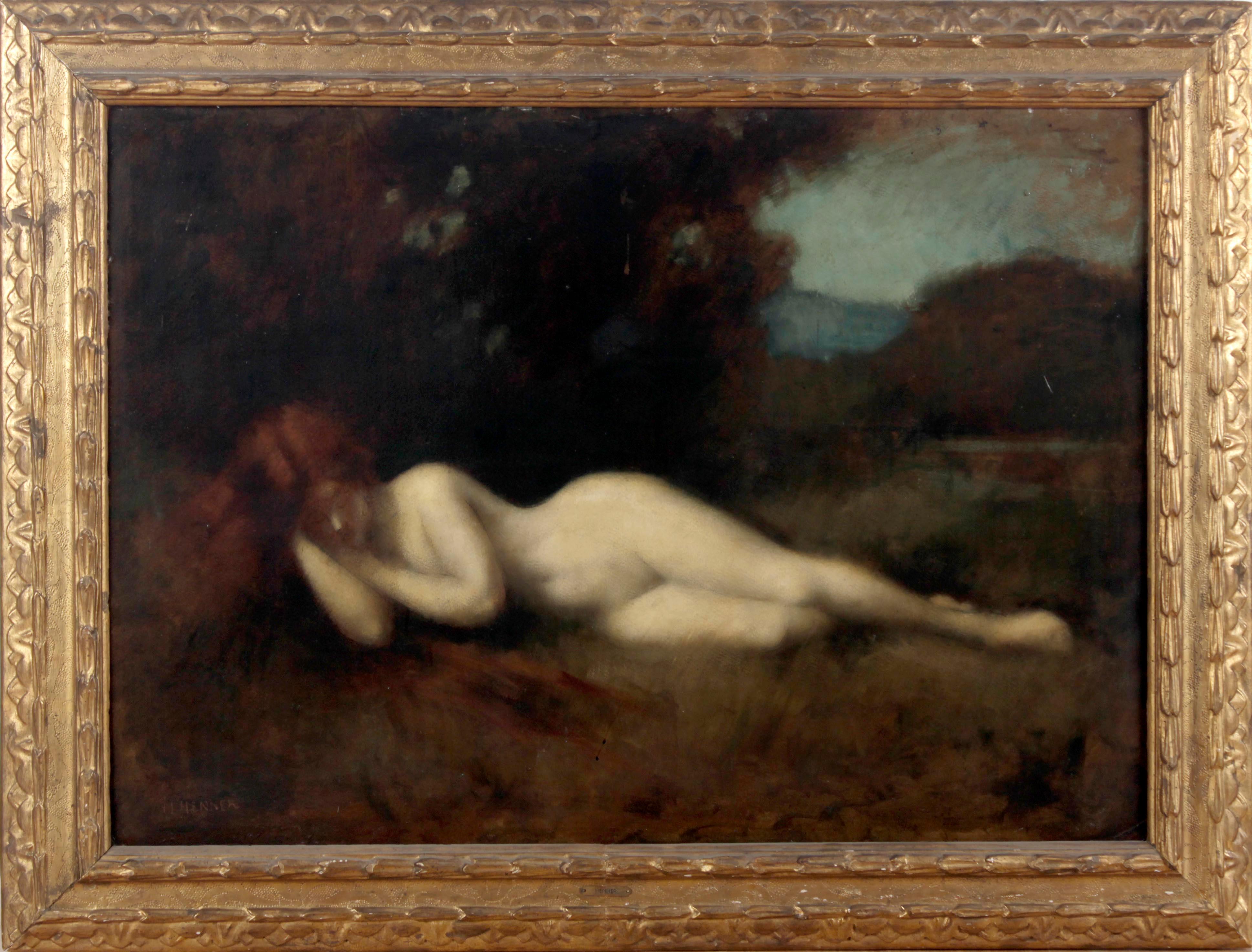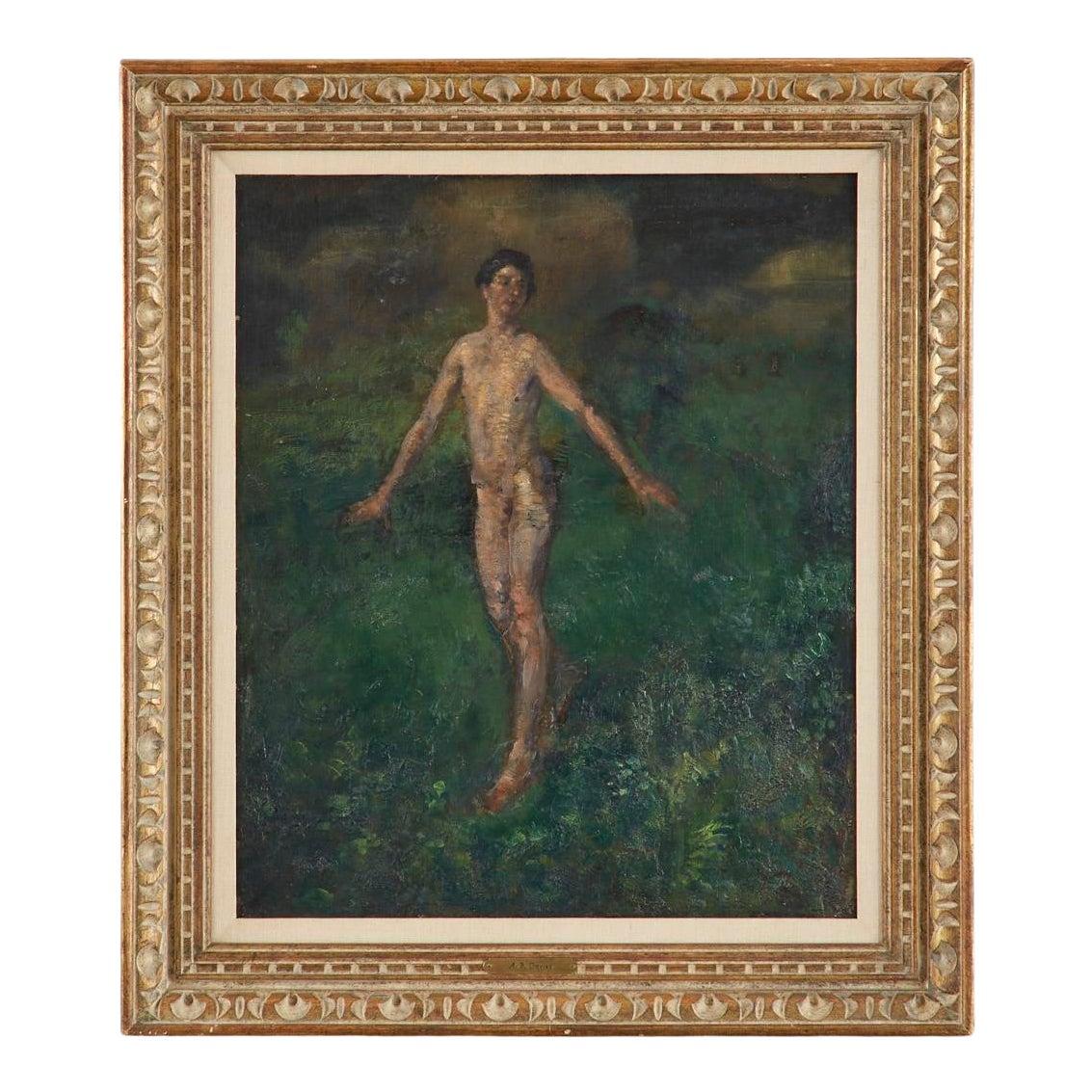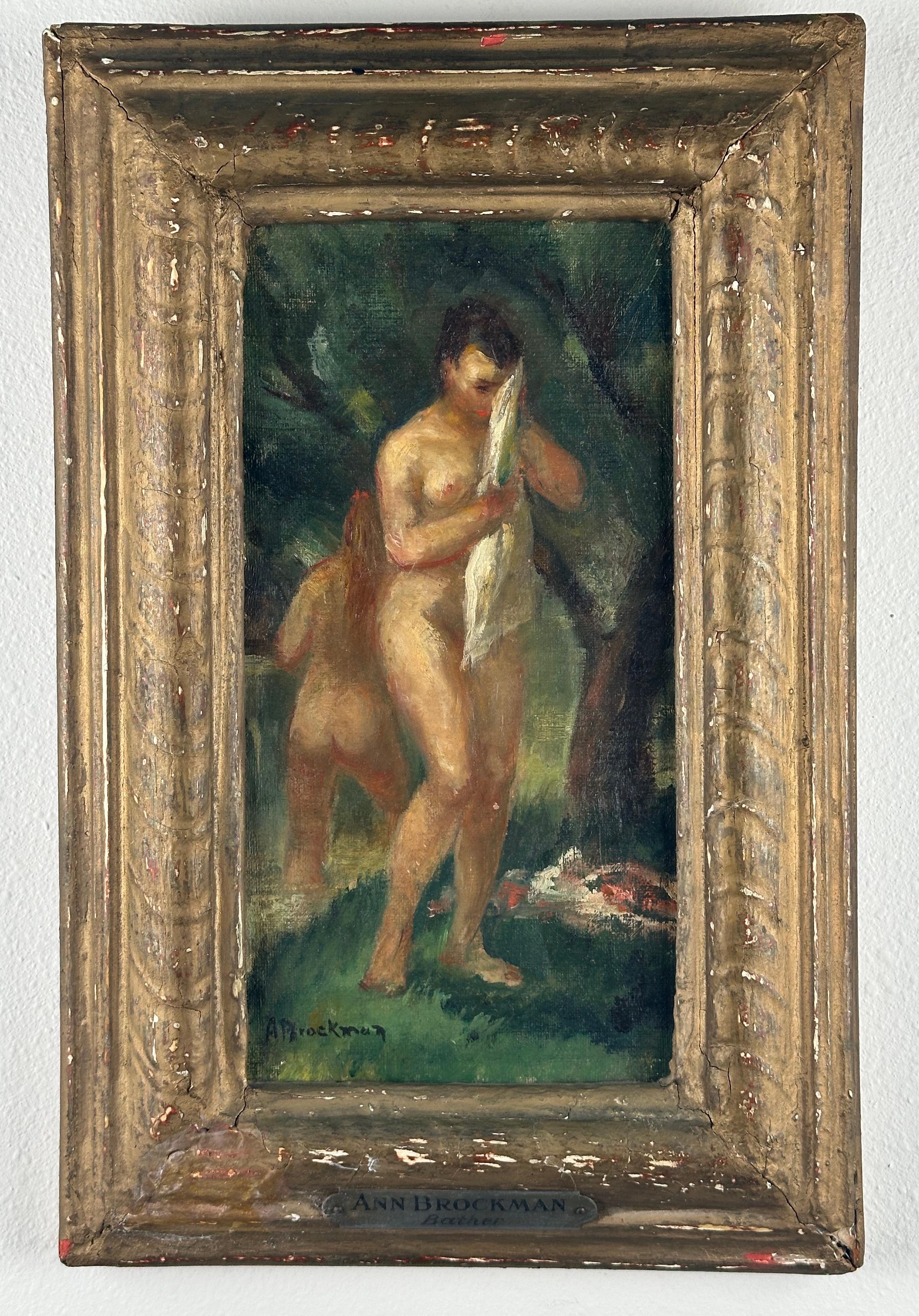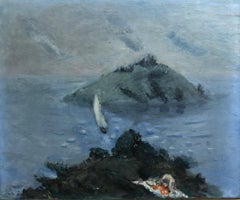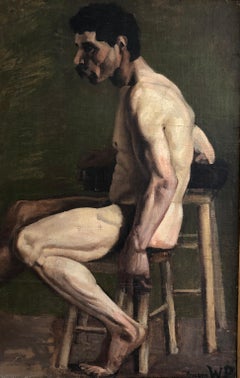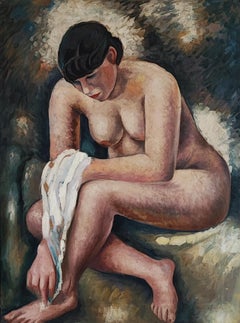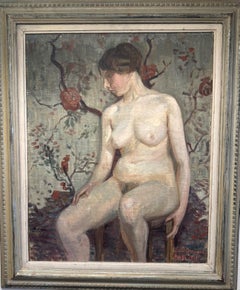Items Similar to Nude in the studio
Want more images or videos?
Request additional images or videos from the seller
1 of 17
Maurice LegendreNude in the studio1949
1949
About the Item
Work on canvas
Molded frame
Diensions with frame : 87 x 73.5 x 4.5 cm
This captivating work depicts a female nude in a dynamic pose, combining softness and tension. Every curve of the body is finely rendered, demonstrating remarkable technical mastery. The nuanced use of light highlights the texture of the skin, creating a subtle contrast with the blurred greenish background. This color palette highlights the sculptural form of the subject, accentuating the impression of movement and life. The figure, turned and slightly tilted, seems to capture an ephemeral moment, inviting introspective contemplation. The carefully averted gaze preserves the intimacy of the scene, while allowing the viewer to immerse himself in the emotional power of the composition. This balance between realism and impressionism lends the work a timeless depth and modernity.
- Creator:Maurice Legendre (1929 - 1955, French)
- Creation Year:1949
- Dimensions:Height: 28.94 in (73.5 cm)Width: 23.63 in (60 cm)Depth: 0.79 in (2 cm)
- Medium:
- Movement & Style:
- Period:
- Condition:Original frame.
- Gallery Location:Genève, CH
- Reference Number:1stDibs: LU2018211226572
About the Seller
5.0
Vetted Professional Seller
Every seller passes strict standards for authenticity and reliability
1stDibs seller since 2022
145 sales on 1stDibs
Typical response time: 9 hours
- ShippingRetrieving quote...Shipping from: Genève, Switzerland
- Return Policy
Authenticity Guarantee
In the unlikely event there’s an issue with an item’s authenticity, contact us within 1 year for a full refund. DetailsMoney-Back Guarantee
If your item is not as described, is damaged in transit, or does not arrive, contact us within 7 days for a full refund. Details24-Hour Cancellation
You have a 24-hour grace period in which to reconsider your purchase, with no questions asked.Vetted Professional Sellers
Our world-class sellers must adhere to strict standards for service and quality, maintaining the integrity of our listings.Price-Match Guarantee
If you find that a seller listed the same item for a lower price elsewhere, we’ll match it.Trusted Global Delivery
Our best-in-class carrier network provides specialized shipping options worldwide, including custom delivery.More From This Seller
View AllLandscape with a naked woman with a towel
Located in Genève, GE
Work on canvas
Category
20th Century Nude Paintings
Materials
Oil
Naked man posing seated
Located in Genève, GE
Work on canvas laid down on panel
Wooden frame and gilded plaster
100 x 70.5 x 4 cm
Category
20th Century Nude Paintings
Materials
Oil
Young woman with towel
Located in Genève, GE
Work on canvas
Category
20th Century Nude Paintings
Materials
Oil
$1,060
Leda
Located in Genève, GE
Work on canvas
Golden wooden frame
55.5 x 129.5 x 3.5 cm
Category
1920s Nude Paintings
Materials
Oil
$12,451
Sitting naked
Located in Genève, GE
Work on wood
Black wooden frame
77 x 55 x 2 cm
Category
1960s Nude Paintings
Materials
Oil
Naked woman in front of the fireplace
By Aloys Hugonnet
Located in Genève, GE
Work on canvas
Category
Early 20th Century Nude Paintings
Materials
Oil
You May Also Like
Suggestive Nude of a Woman oil on canvas painting
Located in Barcelona, Barcelona
Technical Sheet
Title: "Suggestive Nude of a Woman"
Artist: Rosendo González Carbonell (1910-1985)
Technique: Oil on canvas
Dimensions: 36.2 x 28.7 inches
Framing: Unframed
Signed: Y...
Category
1970s Impressionist Nude Paintings
Materials
Oil, Canvas
$1,059 Sale Price
43% Off
Paris Model
Located in Täby, SE
Julie Elise Hullgren, born July 29, 1879 in Aalborg, Denmark, died 1963, was a Danish-Swedish painter. She was the daughter of director J.G. Dinesen and Vilhelmine Marie Rodskier and...
Category
1910s Impressionist Nude Paintings
Materials
Wood Panel, Oil
$2,165 Sale Price
20% Off
Nymphe endormie
By Jean-Jacques Henner
Located in PARIS, FR
Conditions : Good overall Conditions. Old varnish and minor retouching on the nose.
Orignal frame in excellent condition. Medal plate Henner.
Jean-Jacques Henner was born on March 5...
Category
1890s Impressionist Nude Paintings
Materials
Oil
Boy Oil on Canvas
By Arthur Bowen Davies
Located in Rio Vista, CA
Exquisite oil on canvas painting by artist Arthur Bowen Davies (American 1862-1928). The work depicts a young nude man walking through a lush green, ethereal landscape. Thick earth-t...
Category
19th Century American Impressionist Figurative Paintings
Materials
Canvas, Oil
Nude Woman, Original Oil Painting, Handmade Artwork, One of a Kind
Located in Granada Hills, CA
Artist: Ashot Muradyan
Work: Original Painting, Handmade Artwork, One of a Kind
Medium: Oil on Linen
Year: 2022
Style: Impressionism,
Subject: Nude Wo...
Category
2010s Impressionist Nude Paintings
Materials
Canvas, Oil
Female Bather (Nude Women)
Located in Wilton Manors, FL
Ann Brockman (1895–1943) was an American artist who achieved success as a figurative painter following a successful career as an illustrator. Born in California, she spent her childhood in the American Far West and, upon marrying the artist William C. McNulty, relocated to Manhattan at the age of 18 in 1914. She took classes at the Art Students League where her teachers included two realist artists of the Ashcan School, George Luks and John Sloan. Her career as an illustrator began in 1919 with cover art for four issues of a fiction monthly called Live Stories. She continued providing cover art and illustrations for popular magazines and books until 1930 when she transitioned from illustrator to professional artist. From that year until her death in 1943, she took part regularly in group and solo exhibitions, receiving a growing amount of critical recognition and praise. In 1939 she told an interviewer that making money as an illustrator was so easy that it "almost spoiled [her] chances of ever being an artist."[1] In reviewing a solo exhibition of her work in 1939, the artist and critic A.Z Kruse wrote: "She paints and composes with a thorough understanding of form and without the slightest hesitancy about anatomical structure. Add to this a magnificent sense of proportion, and impeccable feeling for color and an unmistakable knowledge of what it takes to balance the elements of good pictorial composition and you have a typical Ann Brockman canvas."[2]
Early life and training
Brockman was born in Northern California in 1895 and spent much of her youth in nearby Oregon, Washington, and Utah.[1][3] She met the artist William C. McNulty in Seattle where he was employed as an editorial cartoonist. They married in March 1914 and promptly moved to Manhattan where he worked as a freelance illustrator.[4][5] At the time of their marriage, Brockman was 18 years old.[6] Over the next few years, her career generally followed that path that her husband had previously taken. His art training had been at the Art Students League beginning in 1908; she began her training there after moving to New York in 1914.[1] After an early career as an editorial cartoonist, he freelanced as a magazine and book illustrator beginning in 1914; she began her career as a magazine and book illustrator in 1919.[7] He embarked on a teaching career in the early 1930s and not long after, she began giving art instruction.[8][9] While they both adhered to the realist tradition in art, their usual subjects were different. His prominently depicted urban cityscapes in the social realist whereas hers generally focused on rural landscapes. He was best known for his etchings and she for her oils and watercolors.[8][10]
Brockman returned to the Art Students League in 1926 to take individual instruction for a month at a time from George Luks and John Sloan.[1] Despite their help, one critic said McNulty's "sympathetic encouragement and guidance" was more important to her development as a professional artist.[11]
Career in art
In the course of her career as illustrator, Brockman would sometimes paint portraits of celebrities before drawing them, as for example in 1923 when she painted the French actress Andrée Lafayette who had traveled to New York to play title role in a film called Trilby.[12] She would also sometimes accept commissions to make portrait paintings and in 1929 painted two Scottish terriers on one such commission.[13] During this time, she also produced landscapes. In 1924 she displayed a New England village street scene painting in the Second Annual Exhibition of Paintings, Watercolors, and Drawings in the J. Wanamaker Gallery of Modern Decorative Art.[14] Available sources show no further exhibitions until in 1930 a critic for the Boston Globe described one of her portraits as "well done" in a review of a Rockport Art Association exhibition held that summer.[15]
Between 1931 and her death in 1943, Brockman participated in over thirty group exhibitions and five solos.[note 1] Her paintings appeared in shows of the artists' associations to which she belonged, including the Rockport Art Association, Salons of America, Society of Independent Artists, and National Association of Women Painters and Sculptors.[17][19]Between 1932 and 1935, her paintings appeared frequently in New York's Macbeth Gallery.[20][23][25][27] She won an award for a painting she showed at the Art Institute of Chicago in 1940.[41] In 1942, the Whitney Museum bought one of the paintings she showed in its Biennial of that year.[10] Critical praise for her work steadily increased during the decade that ended with her untimely death in 1943. In 1932, her painting called "The Camera Man" was called "a clever piece of illustration."[21] Three years later, a painting called "Small Town" gave a critic "the impression of freshness, honesty, and skill".[29] In 1938, a critic described her "Folly Cove" as "masterful" and said "Pigeon Hill Picnic" was "sustained by excellence of execution".[48] At that time, Howard Devree of the New York Times saw "evidence of gathering powers" in her work and wrote "she imparts a dramatic feeling to landscape. She even manages this time to do trees touched by Autumn tints without calendar effect, which is no small praise."[51] Three years later, a Times critic reported Brockman had "set herself a new high" in the watercolors she presented,[52] and another critic said the gallery where she was showing had not "for some time" shown "so outstanding a solo exhibitor as Ann Brockman."[2] Shortly before her death, a critic for Art News maintained that she was "one of America's most talented women painters".[46]
After she had died, a critic said Brockman's paintings "displayed real power", adding that she was "highly rated among the nation's professional artists" and was known to give "aid and encouragement, always with a smile," both artists and to her students.[10] in reviewing the memorial exhibition at the Kraushaar Galleries held in 1945, reviewers wrote about the strength and vibrancy of her personality, the quality of her painting ("every bit as good, possibly better than people had thought"),[53] called her "one of the best of our twentieth century women painters", and credited "her sense of the vividness of life" as a contributor to "the unusual breadth that is so characteristic of her work.[11] One noted that her work was "widely recognized throughout the country" and could be found in the collections of prominent museums, including the Metropolitan Museum of Art, the Whitney Museum of American Art, and the Art Institute of Chicago.[54] Writing in the Times, Devree wrote, "even those who had followed the steady growth of this artist for more than a decade, each successive show being at once an evidence of new achievement and an augury of still better work to come, may well be surprised at the combined impact of the selected paintings in the present showing,"[55] and writing in the Brooklyn Daily Eagle, A.Z Kruse said she had made "extraorginary accomplishments", painted with "inordinate distinction" showing a "lyrical majesty," and possessed "a keen esthetic sense which did not deviate from truth."[54]
Artistic style
(1) Ann Brockman, undated drawing, black chalk on paper, 18 x 22 inches
(2) Ann Brockman, High School Picnic, about 1935, oil on canvas, 34 1/4 x 44 1/4 inches
(3) Ann Brockman, untitled landscape, about 1943, watercolor and pencil on paper, 15 1/4 x 22 1/2 inches
(4) Ann Brockman, North Coast, undated watercolor, 21 1/2 x 30 inches
(5) Ann Brockman, On the Beach, 1942, watercolor on paper, 16 1/2 x 20 inches
(6) Ann Brockman, Lot's Wife, 1942, oil on canvas, 46 x 35 inches
(7) Ann Brockman, New York Harbor, 1934, watercolor on paper, 13 1/2 x 19 1/4 inches
(8) Ann Brockman, Youth, 1942, oil on board, 13 1/2 x 11 1/2 inches
Brockman was a figurative painter whose main subjects were rural landscapes and small-town and coastal scenes. She worked in oils and watercolors, becoming better known for the latter late in her career. Most of her paintings were relatively small. Although she made figure pieces infrequently, the nudes and circus and Biblical scenes she painted were seen to be among her best works. In 1938, Howard Devree wrote: "Her gray-day marines and coast scenes are familiar to gallery goers and are favorites with her fellow artists. Her figure pieces have attained a sculptural quality without losing warmth or taking on stiffness. One spirited circus incident of equestriennes about to enter the big tent compares not unfavorably with many of the similar pictures by a long line of painters who have been fascinated by the theme. She imparts a dramatic feeling to landscape. She even manages this time to do trees touched by Autumn tints without calendar effect, which is no small praise."[51] Similarly, a critic for Art Digest wrote that year: "Fluently and virilely painted, [her] canvases suggest a close affinity between nature and humans. The artist takes her subjects out in the open where they may picnic or bathe with space and air about them. A fast tempo is felt in the compositions of restless horses and nimble entertainers busily alert for the coming performance. Miss Brockman is also interested in portraying frightened groups of people, hurrying to safety or standing half-clad in the lowering storm light."[56]
Her palette ranged from vivid colors in bright sunlight to somber ones in the overcast skies of stormy weather. Of the former, one critic spoke of the rich colors and "sun-drenched rocks" of her coastal scenes and another of her "summery landscapes of coves and picnics."[11][50] Of the latter, Howard Devree said she "painted so many moody Maine coast vignettes of lowering skies and uneasy seas that artists have been heard to refer to an effect as 'an Ann Brockman day'".[57]
Brockman's handling of Biblical subjects can be seen in the oil called "Lot's Wife", shown above, Image No. 6. Her watercolor called "On the Beach" and her oil portrait called "Youth" may both indicate the "sculptural quality" that Devree said was typical of her figure pieces (Image No. 8, above).
An example of Brockman's bright palette in a typical summer theme is the oil painting called "High School Picnic" shown above, Image No. 2. Next to it is a painting, an untitled landscape of about 1943 whose medium, watercolor on paper, shows off the sunny palette she often used (Image No. 3).
Among the darkest of her works was an untitled 1942 drawing she made in black chalk (shown above, Image No. 1). In a book called Drawings by American Artists (1947), the artist and art editor Norman Kent noted that this study influenced her painting through its use of "forms" that were "elastic" and suggested "color". He said its "massing of dark and light" created "a definite mood" that was "impressionistic" and had "the strength of a man's work".[58] Brockman's undated watercolor called "North Coast" (shown above, Image No. 4) is an example of the paintings to which Kent referred.
Illustrator
(9) Ann Brockman, cover, March 12, 1917, Every Week magazine
(10) Illustration of an article, "The Taking of a Salient" by Henry Russell...
Category
1930s American Impressionist Nude Paintings
Materials
Oil
$1,200 Sale Price
20% Off
Recently Viewed
View AllMore Ways To Browse
Female Studio Nude
Female Nudes Mid Century
Agustin Cardenas
Al Hirschfeld Hollywood
Alexej Von Jawlensky
Andy Warhol Beatles
Andy Warhol Joseph Beuys
Andy Warhol Muhammad Ali
Andy Warhol Queen Elizabeth
Andy Warhol Shoe Drawings
Antibes Poster
Antique Manga
Antique Poupee
Antonio Mancini
Arman Venus
Astro Boy
Athena Ceramic
Bahamian Art
